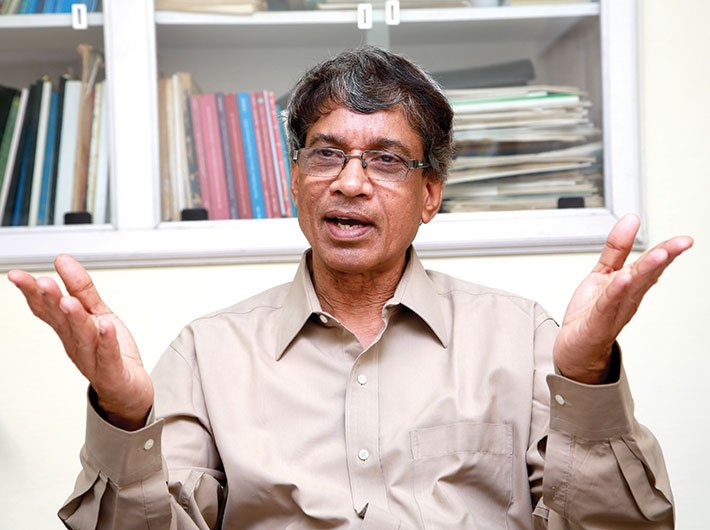India’s leading water expert and president of the South Asia Consortium for Interdisciplinary Water Resources Studies, S Janakarajan, wonders why Chennai, a city that receives 1,250 mm rainfall, is called a thirsty city and goes on to explain to Shivani Chaturvedi what went wrong among the southern states that led to a water-war like situation. But, he warns that such a scenario will keep occurring if the government does not come up with a lasting solution.
There is a war-like situation in the south over water sharing. Why is there a water crisis?
The most important reason for this is the increase in demand for water from all sectors including agriculture, industry and urban areas. In the last few years, urbanisation is taking place rapidly all over the country and more so in the southern states. Tamil Nadu is considered the most urbanised state in the country with around 48 percent of the population living in urban areas. Even Andhra Pradesh, Karnataka and Kerala are not lagging behind. There is an increase in population too.
If we put all this in perspective, we will know that while supply of water is limited, the demand has been on the rise. This is something unusual that we are experiencing. We need to understand, analyse and historically look at how this demand went up and what we have done wrong.
Are these states water deficit?
I don’t think so. We need to question our water management and conservation techniques. Our drinking water needs have been increasing. Bengaluru needs around 20 tmc [thousand million cubic] feet water per annum for drinking purposes. I am told that their daily demand for drinking water is around 1,300-1,400 million litres. About 30 to 40 percent of water is wasted in transmission, distribution and leakages.
Thus, arresting losses would save water and increase supply. Whenever there is a deficit of water, we only think about water supply augmentation which is our standard water management technique, whether it is for drinking, industrial or agricultural use. We should streamline the distribution system, and have a mechanism to reuse water.
Our irrigation system and canal networks are age-old. We need to modernise the canal network and introduce new and modern control structures so that we know how much water is required for each crop and for land, so that only that much water is supplied.
Chennai receives 1,250 mm of rainfall. Even with so much rainfall, why is it called a thirsty city? Why should it get water from Telugu Ganga? This is where we lack imagination, consolidation of knowledge and application. Last year, Chennai had floods; 300 tmc feet water went into the sea. But 3,600 tanks that are located just above Chennai city in two adjoining districts – Kancheepuram and Thiruvallur – remained dry. With floods why are these tanks dry? The government should have desilted and protected the tanks so that water could be stored. These tanks can hold 80 tmc feet water which is enough to meet the requirement of Chennai for three to four years.
Why did this crisis situation arise?
The Cauvery water dispute also arose because of greed. In the 1900s Tamil Nadu’s total irrigation command area [irrigated land] was about eight or nine lakh acres. Today it is about 17 or 18 lakh acres – or at best it is 20 lakh acres. This area has been developed in the Cauvery basin. In Karnataka it was much less, about 2.5 lakh acres in the 1900s and today it is 2.5 million acres. It is more than what Tamil Nadu has developed. This is greed.
If we really want to provide water to 4.5 million acres in both states, the available water is much less than what is demanded. In addition to this, there is a demand for water for drinking and industrial purposes. Tamil Nadu’s 70 percent of drinking water needs depend on the Cauvery. Drinking water needs of Bengaluru and many other cities in Karnataka too depend on the Cauvery. But we don’t have that much water.
Even in Kerala, water demand has gone up tremendously in recent times. It is not just the demand from the agriculture sector, but expanding towns, urban areas, education institutions and tourism industry. Kerala is also expanding the irrigation command area.
While building our cities or expanding industries we never think about whether we have that kind of infrastructure for meeting water needs. If we ignore this aspect, we will naturally land in trouble and this is precisely what is happening. We should have provisions for recycling. For instance, the Noyyal river tributary of the Cauvery river flows through Tirupur district of Tamil Nadu. From Tirupur town alone, knitwear products worth '25,000 crore are exported annually. This industry needs water for dying and bleaching. And water demand for this industry alone in and around Tirupur is met from the Cauvery basin. This used water, whether it is treated, semi-treated or under-treated, goes back to the Cauvery basin and is polluting it. All tributaries of the Cauvery river, including Bhavani and Amaravathi, are polluted.
Hence, water management issue [needs a] holistic view. It is high time our policymakers and governments thought seriously about conservation of water. Some sort of collaboration or agreement should emerge between the five southern states not only for sharing natural resources but also for introducing modern technologies. These states should come to some kind of understanding and establish long-standing dialogue mode. Otherwise, these tussles are bound to become very serious in the days to come.
The Indus water treaty introduced in 1960 stays despite the fact that India and Pakistan fought three wars, but within the states in our country, we have got a war-like situation and there is absolutely no cooperation. Moreover, there is unhealthy competition. The list of water wars includes Mullaperiyar dam issue between Tamil Nadu and Kerala, row between Andhra Pradesh and Telangana over Krishna water sharing, agreement between Tamil Nadu and Andhra Pradesh over Krishna water release through Telugu Ganga project, dispute between Tamil Nadu and Kerala over river Siruvani and the bitterest Cauvery water issue.
Can you point out the historical mistakes behind this situation?
There was a historical blunder and Karnataka always says that injustice was meted out to them because of the old agreement between the then princely state of Mysore and Madras presidency, when Karnataka was not allowed to construct a dam till the 1930s.
However, in 1924 Karnataka was allowed to construct the Krishna Raja Sagara dam and Mettur dam in Tamil Nadu. After 1974, the 50-year-old agreement was never renewed and so Karnataka constructed a series of reservoirs and withheld water and developed irrigation command area at the cost of irrigation command area already developed in Tamil Nadu. Unfortunately, both states didn’t realise the availability of water and how much could be used.
The Cauvery is a deficit basin. It does not have water to the extent that is needed. The dispute is about sharing of the already utilised water, whereas in other water disputes, it is over sharing of surplus, unutilised water.
What is the crop pattern in these states? Will shift in crop pattern help in saving water?
In Karnataka, the irrigated land is not that old and it is producing crops like sugarcane, bananas and groundnuts. Mandiya district is considered as the sugarcane lobby. It is also considered a strong political lobby. It also has a rice and paddy belt which consumes more water. However, in Tamil Nadu, irrigation dates back to thousands of years. It is a delta and water has been flowing since such a long time that they can’t grow any other crop but paddy. Now the state is trying to grow sugarcane, banana, pulses and cotton, but there is poor yield. Tamil Nadu has got very little option of bringing change in the crop pattern. Karnataka has the option to bring change in the crop pattern as the soil type is not clay, and save water.
Kerala too has got very few options. They have paddy crop, rubber and tea. In Andhra Pradesh, the Krishna delta is in bad shape. Now there is mushrooming of shrimp cultivation which contributes negatively to agriculture and the environment. However, the Krishna basin is basically paddy producing which again consumes lot of water.
shivani@governancenow.com
(The interview appears in the October 16-31, 2016 issue)

